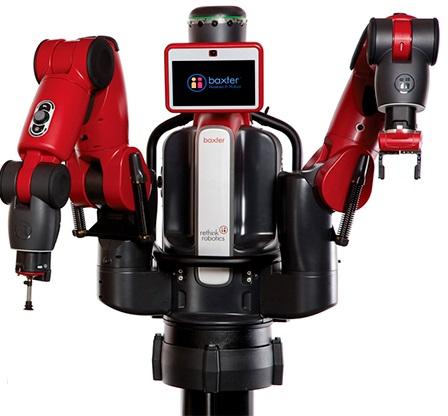Baxter Research Robot
|
Baxter
|
|
|---|---|
 |
|
| Status: Active with limitations, contact the lab manager | |
Superusers
- Ivan Penskiy (ipenskiy@umd.edu)
Overview
Baxter from Rethink Robotics is a humanoid robot designed for research in human-safe robotic manufacturing and human-assistive robotics. It has two 7-axis arms, integrated cameras, sonar, torque sensors, and direct programming access via a standard ROS (Robot Operating System) interface. Baxter comes with both electronically controlled and vacuum grippers and a mobile pedestal to easily move the robot.
Location
Brendan Iribe Center (Bldg. 432), room 0116.Physical specifications
| Maximum reach | 1210 mm |
| Degrees of freedom | 14 (7 per arm) |
| Maximum payload (including end effector) | 2.2 kg |
Important documents and useful links
Reservation
Baxter must be reserved before using. The reservation is done using the Google calendar (IRB-0116ba). Users will be able to reserve the equipment personally after attending the RML lab orientation and then following the steps below to gain access to the equipment.
Video demonstration
The following videos demonstrate capabilities and the some aspects of operating the Baxter robot:Important reminders
- While this is designed as a human-safe robot, it is still a big robot that can do a lot of damage. Make sure the red emergency stop button is accessible at all times.
- Be generally careful when working with Baxter.
- Baxter runs on Ubuntu 14.04 and ROS Indigo. Baxter Gazebo simulation is also available on Ubuntu 16.04 and ROS Kinetic.
TBD
Shutting down procedures
- Bring arms in the neutral position and disable Baxter.
- Make sure the end effectors are not in the close vicinity to foreign objects (e.g. tables).
- Do not hold in the power button when shutting down! Do not unplug the robot while it is in the process of shutting down! These can cause hard drive corruption on the next boot.
- Turn OFF Baxter by pressing power button in the back just for a second.
Gaining access to equipment
- Preparation:
Baxter has several well defined and structured online tutorials, RML expects users to be familiar with Baxter robot specs and capabilities as well as its basics of operation. Specifically, users should have knowledge of the following topics:- ROS framework, one should go through the ROS tutorials for basic understanding.
- ROS packages for running Baxter. For instance, this manual provides all the steps necessary to get started on Baxter in ROS.
- Gazebo simulation and control using MoveIt.
- Scheduling:
Once you are confident in the topics from the previous section, email the lab manager (Ivan Penskiy, ipenskiy@umd.edu) to schedule the instruction session. Instruction session:
In the beginning of the session the user will be asked several questions to test the knowledge of Baxter and the basics of ROS framework. The user also will have to demonstrate a Gazebo simulation of Baxter. The following are the deliverables for the simulation:- Spawn Baxter in a map in Gazebo (you can use standard maps from the tutorials).
- Command Baxter to perform a simple action.
- Run Rviz in parallel to Gazebo and show the real-time visualization of the simulation in Rviz.
After confirming knowledge and skills required to operate Baxter, the user will be instructed on rules and technical aspects of using Baxter in RML (network connection, turning ON and OFF procedures, etc).